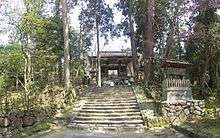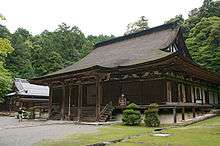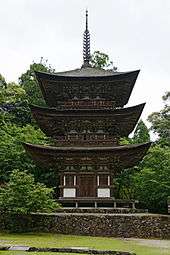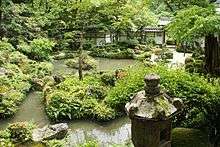Saimyō-ji (Kora)
Saimyō-ji (西明寺), also known as Kotō-sanzan Saimyōji (湖東三山西明寺) or as Ryūōzan Saimyōji (龍應山西明寺) is a Buddhist temple of the Tendai sect in Kōra, Shiga Prefecture, Japan. Founded at the beginning of the ninth century by the 54th Emperor of Japan, the temple is dedicated to Yakushi Nyorai, the Buddha of healing. The complex includes several National Treasures and a garden designated as Place of Scenic Beauty of Japan.
| Saimyō-ji | |
|---|---|
西明寺 | |
 Main building at Saimyō-ji | |
| Religion | |
| Affiliation | Buddhism |
| Sect | Tendai |
| Prefecture | Shiga |
| Region | Kansai |
| Deity | Yakushi Nyorai |
| Location | |
| Municipality | Kōra |
| Country | Japan |
 Shown within Japan | |
| Prefecture | Shiga |
| Geographic coordinates | 35.183972°N 136.284278°E |
| Architecture | |
| Founder | Sanshū |
| Date established | 834 |
| Website | |
| http://www.saimyouji.com | |
History
.jpg)
In 834, at the request of Emperor Ninmyō, the fifty-fourth emperor of Japan, the Buddhist monk Sanshū, of the Tendai sect, which was founded in 805 by Saichō (767-822), built a temple dedicated to Yakushi Nyorai, the Buddha of medicine and healing. This was the temple Saimyō-ji, located about 11 km (6.8 mi), as the crow flies, east of Lake Biwa.[1] The buildings of this Buddhist place of worship were erected on a wooded hillside at the foot of the northwestern slope of the Suzuka Mountains.
At the beginning of the Kamakura shogunate (1192 - 1333), Minamoto no Yoritomo, the first shōgun of the Kamakura period (1185 - 1333), paid an official visit to the temple.[1]
In 1571, during the Sengoku period, in the Siege of Mount Hiei, the daimyō Oda Nobunaga, decided to challenge the power of the warrior monks of the Tendai sect, and destroyed the sect's headquarters at Enryaku-ji on Mount Hiei, above Kyoto. Soon after, a samurai in the service of Nobunaga, Gorōzaemon, burns Saimyō-ji; Only the main building, the three-storey pagoda and the wooden entrance door to the temple escaped the ravages of the fire.[1][2]
Thanks to the interventions of the monks Tenkai (1536 - 1643) and Kōkai (1608 - 1695), during the Edo period (1603 - 1868), the daimyō Mochizuki of Ōmi had the temple complex of Saimyō-ji rebuilt, restoring its status as a major center of Buddhist studies.[1]
On 28 December 1897, six months after the promulgation of the Ancient Temples and Shrines Preservation Law,[note 1][3] the main hall (hondō) of the temple was classified as a National Treasure,[4] a classification confirmed in 1952 under the new Law for the Protection of Cultural Properties (文化財保護法, bunkazai hogohō) promulgated on 30 May 1950 by the Ministry of Education.[5]
As part of state heritage conservation programme, repairs of several classified buildings were carried out during the 2000s.[2]
Legendary name of the temple
According to a legend, on a day in the year 834, the monk Sanshū, on a meditative walk along the western shore of Lake Biwa, would have seen purple clouds[note 2] in the eastern sky across the lake. A dazzling light suddenly appeared. The monk, interpreting this phenomenon as a sign of celestial power, went to the spot where the brilliance of light had formed. There he found a pond on which he began to pray.[2]
In response to his incantations, the Bodhisattva of Sunlight, Nikkō bosatsu, and his brother Gakkō bosatsu, both servants of Yakushi Nyorai, followed by the Twelve Heavenly Generals, protecting divinities of the healing Buddha, manifested themselves before him.[2] Appreciating this miraculous event, Emperor Ninmyō ordered a temple to be built at the place where the divinities of heaven appeared to Sanshū. And as the divine light illuminated the heavens in western direction, that of the imperial capital, the temple was baptized Saimyō-ji (西明寺, lit. the temple of the luminuous shine of the West).[2]
In accordance with a belief within Chinese geomancy, the site of the temple near Lake Biwa to the east of the imperial capital, Heian-kyō, corresponded to an earthly paradise, the centre of cosmic influences in feng shui.[6] The temple was therefore assigned the Azure Dragon, guardian of the East and one of the Four Symbols.[2] The temple's honorific mountain name, Ryūōzan (龍應山, lit. "mountain of the responding dragon"), was meant to signify that every wish was fulfilled at Saimyō-ji. Together with Kongōrin-ji in Aishō and Hyakusai-ji in Higashiōmi the temple forms a group of three temples known as Kotō-sanzan (湖東三山, lit. "three mountains east of the lake").
Architecture
.jpg)
The temple Saimyō-ji is a Buddhist architectural complex that includes a main building, two gates, one of which is an entrance gate (sōmon), and the other a middle gate (nitenmon), enshrining two statues of Niō, two pagodas, one traditional shōrō (bell tower), a chōzuya (ablution pavilion), a garden of sakura, Japanese maples, cedars and cypresses, a landscaped garden (Hōraitei (庭庭)),[note 3] a residence for priests, a reception desk and an information office. Wood and stone are the main building materials.
A steep path, sandō, which leads from the entrance gate to the main gate (nitenmon) of the temple, divides the complex in two. Two onigawara, a shachihoko, and many stone vestiges, such as Buddhist sculptures, lanterns, groups of Jizō, litter the mossy soil of the grounds. At the edge of the sandō, a statue of Saichō, a Buddhist monk who founded the Tendai branch of Japanese Buddhism, recalls the religious affiliation of the temple. A hokora, miniature Shinto shrine, dedicated to the Eastern Guardian Dragon, and another honoring Inari are signs of the historical syncretism between Buddhism and kami worship (Shinbutsu-shūgō).
A corner of the grounds houses a statue of Jūichimenkannon (十一面観音), one of the many manifestations of the Goddess of Mercy with eleven faces. This bronze Kannon sculpture is surrounded by panels supporting shelves on which are aligned hundreds of miniatures of the Buddhist goddess.
Nitenmon

A niōmon, called nitenmon ("the gate of the two celestial kings"), marks the entrance to the temple enclosure. This Muromachi period gateway dates to 1407 and is the oldest extant nitenmon.[7][8] It enshrines on either side of its opening wooden statues of Zōjō-ten, guardian of the south and of Jikoku-ten, guardian of the east; two representatives of the Four Heavenly Kings.[note 4] The gate is entirely made of wood in the hakkyakumon (八脚門) style and has an irimoya style roof.[9]
In 1911, the Saimyō-ji nitenmon made its appearance on the list of Important Cultural Properties established by the Japanese State.[10]
Main hall

Dating to the end of the Kamakura period, the temple's main hall (本堂, hondō), also known as ruriden and classified as a National Treasure, is a hinoki cypress wood construction without any nails.[1] It is a 7×7 ken single-storied, irimoya style construction with a 3 ken step canopy. The roof is covered with bark shingles. The building serves as a place of meditation for the faithful of the Tendai school.[11]
The building, with an area of approximately 160 m2 (1,700 sq ft), houses Kamakura period wooden sculptures of the Twelve Heavenly Generals, three statues forming the Pure Land Triad: Amida Nyorai surrounded by Kannon Bosatsu and Seishi Bosatsu, two gilded statuettes representing Nikkō Bosatsu and Gakkō Bosatsu, terracotta miniatures of the monks Ryōgen and Shinran from the Muromachi period, and several important national cultural objects: an icon of Yakushi Nyorai from the Heian period, statues of Shaka Nyorai (Kamakura period), Fudō Myōō, works of the monk Enchin dating from the beginning of the Heian era, Kōmoku-ten and Tamon-ten (Heian period) , two of the Four Heavenly Kings of Chinese Buddhist Mythology.[1]
Saimyō-ji is the 32nd step on a pilgrimage route installed in 1989 in the Kansai region connecting 49 holy sites dedicated to the Buddhist deity Yakushi Nyorai.[note 5] The first is Yakushi-ji in Nara and the last Enryaku-ji in Kyoto. A building near to the main hall is set up to receive the pilgrims and the temple provides each with a certificate stamped with the official seal attesting their passage.[12]
Hōtō
Behind the main building of the temple, a wooden staircase leads to a clearing. In this isolated place, a Kamakura period hōtō (宝塔) or treasure pagoda made of granite . This Important Cultural Property from 1304 is a monument commemorating the founding of Saimyō-ji.[13][14]
Three-storied pagoda

The Saimyō-ji complex contains a 24 m (79 ft) tall, 3×3 ken three-storied pagoda (三重塔, sanjūnotō) in Japanese style. The carpenters from the Hida region who built it towards the end of the Kamakura period used only Japanese hinoki cypress wood and no nails.[1]
On the first floor of the building, murals by painters of the Kose school[note 6] illustrate the Lotus Sutra, which is at the base of the religious corpus of the Tendai branch of Japanese Buddhism, and Dainichi Nyorai and his 32 attendants. They are the only extant Kamakura period murals.[1]
This monument, typical of the architectural style of the Kamakura period, has been classified as a National Treasure since 1952.[16]
Honbō Garden

Beyond the gate of the temple, lies a wooded garden, on the ground covered with moss. Known as Honbō (本坊庭園, Honbō-teien), it contains cedars, cypress, and a large number of Japanese maple trees that are popular in autumn during leaf peeping season. Spring blossoms in the garden include pink and white flowers of Yoshino cherry trees, mountain cherry (yamazakura), spring cherry (higanzakura), white bell-shaped flowers of Enkianthus perulatus, flower beds of Rhododendron and hydrangea.[11]
From the beginning of September until November, the garden is a popular spot for autumn hanami, when the toad lilies, camellias, Japanese maple and fudan zakura (不断桜), a late blooming cultivation of a Japanese ornamental cherry tree, give the full measure of their flowering.[1][17] Some of these ornamental cherry trees were planted in the mid-eighteenth century.[1]
Near the Nitenmon, two Japanese cedars (Cryptomeria japonica), joined at the base of their trunks, form a pair of siamese trees. A shimenawa surrounding them emphasizes the sacredness of this "married couple" (夫婦, meoto). Associated with the much younger cedar that grows to a few centimeters from their contiguous trunks, they symbolize a family to which a Local belief attributes miraculous properties: it would be enough to put hands on their roots or trunk to ensure good health, longevity, a harmonious couple life, family prosperity or even a painless childbirth.[11]

The garden, which has been listed as a Place of Scenic Beauty of Japan since 1987, includes a landscaped garden known as Hōrai Garden (庭庭, Hōraitei), a donation by the daimyō Mochizuki on the occasion of the celebration of the reconstruction of the Temple in 1673.[18] With its stones representing the triad of the Pure Land, Nikkō and Gakkō Bosatsu, and the Twelve Heavenly Generals, this expanse of greenery constitutes an allegory of Mount Penglai of Chinese mythology.[note 3][1] Among the plants on an island in its koi pond, emerge stones whose shapes resemble a tortoise or a paper crane, traditional figures of the Japanese art of folding paper.[1]
Notes and references
Notes
- Ancient Temples and Shrines Preservation Law (古社寺保存法, koshaji hozonhō)
- Purple clouds (紫雲, Shiun) are a good omen in Mahayana Buddhist mythology
- The name of this garden is an allusion to Mount Penglai (蓬萊山, Hōraisan), a place of eternal youth and paradise of Chinese mythology.
- The prefix niten (二天) designates two of the Four Heavenly Kings.
- 西国薬師四十九霊場 (Saigoku Yakushi shijūku reijō)
- Kose School (巨勢派, Koseha), school of painters founded by Kose Kanaoka in the 9th century.[15]
References
- "The Saimyōji Temple". Saimyō-ji. 2015. Retrieved 2 December 2016.
- 西明寺略縁起 [Saimyō-ji : historical overview] (in Japanese). Saimyō-ji. 2014. Retrieved 2 December 2016.
- 古社寺保存法(明治三十年六月十日法律第四十九号 [Ancient Temples and Shrines Preservation Law (No. 49), 10)] (in Japanese). Ministry of Education, Culture, Sports, Science and Technology. 2016. Retrieved 2 December 2016..
- 西明寺本堂 [Saimyō-ji Hondō]. Cultural Heritage Online (in Japanese). Agency for Cultural Affairs. Retrieved 2 December 2016..
- 文化財保護法(昭和二十五年法律第二百十四号)(抄) [Law for the Protection of Cultural Properties (No. 214, 1950)] (in Japanese). Ministry of Education, Culture, Sports, Science and Technology. 2016. Retrieved 2 December 2016..
- David Young; Michiko Young; Tan Hong Yew (2012). The Art of Japanese Architecture. New York: Tuttle Publishing. p. 109. ISBN 978-1462906574. OCLC 794664020.
- "Nitenmon". Japanese Architecture and Art Net Users System. 2016. Retrieved 9 December 2016.
- 西明寺二天門 [Saimyō-jiNiten-mon] (in Japanese). Kōra town. Retrieved 3 December 2016..
- "Hakkyakumon". Japanese Architecture and Art Net Users System. 2016. Retrieved 3 December 2016..
- 西明寺二天門 [Saimyō-ji Niten-mon]. Cultural Heritage Online (in Japanese). Agency for Cultural Affairs. Retrieved 3 December 2016.
- 寺院散策 [A walk around the temple] (in Japanese). Saimyō-ji. 2013. Retrieved 3 December 2016..
- 西国薬師四十九霊場会 [Yakushi pilgrimage of 49 temples in western Japan] (in Japanese). 西国薬師四十九霊場会事務局. 2012. Retrieved 3 December 2016..
- 石造宝塔(重要文化財) [Miniature pagoda (sekizōhōtō), designated as Important Cultural Property] (in Japanese). Saimyō-ji. 2002. Retrieved 3 December 2016.
- 西明寺宝塔 [Saimyō-ji hōtō] (in Japanese). Kōra town. 2002. Retrieved 7 December 2016.
- "Koseha". Japanese Architecture and Art Net Users System. 2016. Retrieved 3 December 2016..
- 西明寺三重塔 [Saimyō-ji three-storeyed pagoda]. Cultural Heritage Online (in Japanese). Agency for Cultural Affairs. Retrieved 3 December 2016..
- 西明寺花ごよみ [Flower calendar Saimyō-ji] (in Japanese). Saimyō-ji. 2009. Retrieved 3 December 2016..
- 西明寺本坊庭園 [Saimyō-ji Honbō garden]. Cultural Heritage Online (in Japanese). Agency for Cultural Affairs. Retrieved 3 December 2016..
See also
External links
| Wikimedia Commons has media related to Temple Saimyō. |
- Official website (ja)
- 滋賀県甲良町 西明寺 [Kōra, Shiga prefecture : Saimyō-ji] (in Japanese). Japan Geographic. 2016. Retrieved 3 December 2016.
Collection of color photographs of Saimyō-ji
. - HealingJapanTV - 滋賀県 湖東三山 西明寺の紅葉 (sounds of nature) on YouTube.